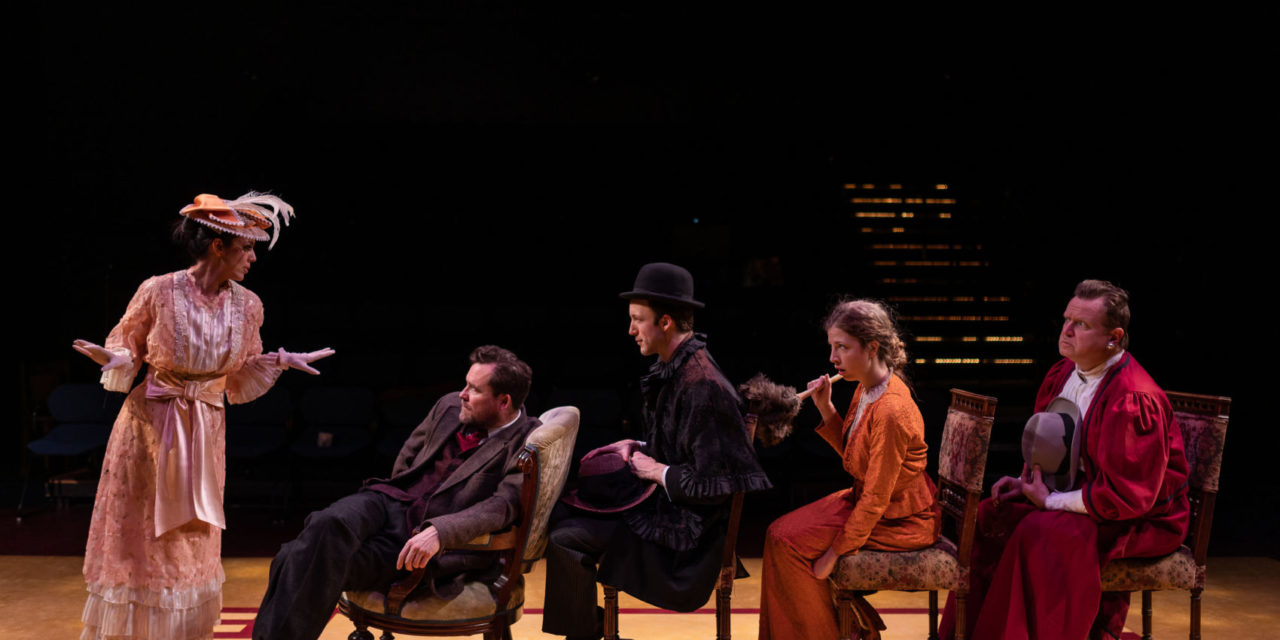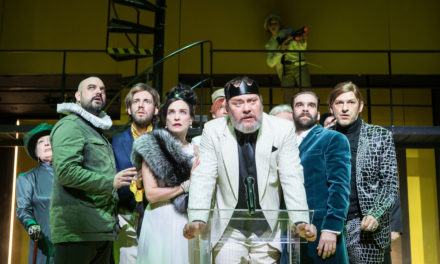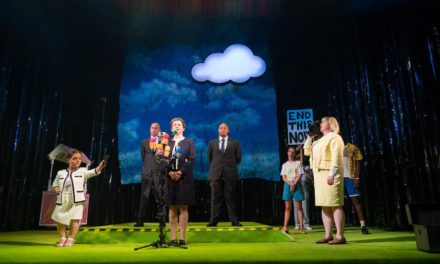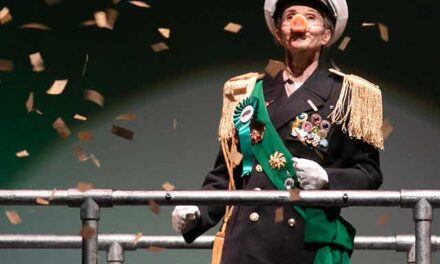After a critically acclaimed run in New York City, Bedlam Theatre Company has brought their production of George Bernard Shaw’s classic play Pygmalion to the Central Square Theatre in Cambridge, Massachusetts. This is not the first time these two companies have joined forces. Central Square Theatre has also played host to other productions from Bedlam such as Shaw’s St. Joan and Shakespeare’s Twelfth Night. The New York-based company has garnered a great deal of praise for its ability to tackle large, wordy plays with energy, dynamism, and panache. Its production of Pygmalion is no different.
The source for Lerner and Loewe’s beloved musical My Fair Lady, Pygmalion tells the story of the phonetician Henry Higgins (Eric Tucker, who also directs) who discovers a lowly flower girl Eliza Doolittle (Vaishnavi Sharma) in the streets of London’s Covent Garden, and bets his friend and colleague, Colonel Pickering (James Patrick Nelson), that he can teach her in proper English, elegance, and decorum, and make her pass as a duchess in only three months. Charmed by the premise, Colonel Pickering chooses to fund the entire project. Eliza happily takes Higgins up on the offer, but as he dresses her, provides for her, and instructs her in elocution, Eliza feels her dignity and individuality trampled upon. As she appears to earn a higher station (through the performance of that station’s manners), she also recognizes how little worth she has in Higgins’ eyes.
As it has been Bedlam’s tradition, the cast is truncated, necessitating that several of the actors play two or more characters. While not quite as ambitious as St. Joan, where four actors played the text’s twenty-five roles, the effect here is the same. Seeing the six actors switch roles and don new outfits—at one point multiple times in the middle of a scene—gives the play some buoyancy, making it all the more playful and exciting. The effect is helped with some judicious cutting. Bedlam has trimmed the play down to a two-hour performance (with no intermission), zipping through some of Shaw’s lengthy speeches.
The staging of the play is simple, elegant, and designed to draw the audience in. In fact, the start of the play catches many of the audience members unaware as they unwittingly become part of a crowded street scene. Once they are allowed to their seats, the audience is positioned in an alley configuration, straddling the stage on two sides. The actors exploit their proximity to the audience, sometimes directly addressing the crowd. The design by Elizabeth Rocha and Joseph Stallone take advantage of the arrangement, putting a focus on efficiency and simplicity. Most scene changes are done through a simple placement of a chair. Through the direction of Tucker, the chairs and a few prop pieces are used to maximum effect. At one point, Tucker positions the actors in four single-file chairs. Without moving from their seats, the actors switch hats, lean over to talk to one another, and somehow create the energy and buzz of a crowded party scene. These creative moments of staging are judiciously applied. They never overwhelm the production, never become the focus, but almost always delight and amuse.
Additionally, the design and staging draw greater attention to the actors, who are each very special. It is an ensemble cast, and each supporting role is just as memorable as the two leads. Edmund Lewis, in particular, turns a hilarious performance as Mrs. Higgins in drag (a nod to the English tradition of the Dame), just as Grace Bernardo plays, among many others, a delightfully irritable Mrs. Pearce, Higgins’ housekeeper. The most noteworthy casting choice, however, is of Sharma and Michael Dwan Singh as Eliza and Alfred Doolittle respectively. These performers re-contextualize the Doolittle’s as Indian immigrants, and so Higgin’s attempts to refashion Eliza take on colonial and imperialist connotations. The idea is a good one, especially given England’s long history with India and its ever-growing South Asian population. The change also relates our own political climate in the United States, where hateful division are drawn around questions of who looks and sounds “American.” In large part, the effect works, but mostly because of the incredibly talented Sharma. Capable of playing both the fire and the vulnerability of Eliza, Sharma brings a compelling, hilarious, and heartbreaking performance.
I do wonder if the company could not have done more to integrate this choice within the fabric of Shaw’s play. Other than the Doolittles’s Indian accents, and a few references to India, Higgins never really addresses the fact that Eliza is an immigrant. His focus on diction and grammar remains a matter of class and status, rather than of culture and language. Bedlam does experiment with a few touches that better integrate Eliza’s Indian heritage. At the beginning of the play, Sharma code-switches from Hindi to English at a rapid pace, which makes her seem out of place amongst the English speakers, an even greater outsider than Shaw’s Cockney Eliza. There was another sublime moment performed at the center of the play when Eliza dons a sari, taking her time to carefully wrap it around her body. Played with soft music in the background, it was mesmerizing to watch, and only further endeared the audience to Eliza. What is more, it was a moment that fully acknowledged Eliza’s Indian ancestry. Tellingly, after Eliza is dressed in the sari, Higgins barely notices her, nor does he even reference the dress. He does not see Eliza for the person she is. He only recognizes the individual he wants her to be, that being a gentile English woman.
Nonetheless, I craved for more of an integration. Bedlam’s biggest departure from Shaw was to add an element of race and nationalism to the piece, and, indeed, doing so brought fresh resonance to the play. However, it was curtailed by a lack of follow through on the company’s part. That is not to detract from the overall performance, which was gritty, funny, fast-paced, and a delight to watch. Amidst the adaptations and staging gimmicks that Bedlam uses to modernize the play, the company stays admirably focused on Shaw’s language. Throughout the course of the performance, I felt I was watching nothing more than an expertly performed version of Pygmalion, perhaps one of the best I have seen. Bedlam earns its laughs, but those laughs can also be credited to Shaw’s witty dialogue. Although it is a cliché to say it, Bedlam breathes new life into the play, shaping Shaw’s classic in their own image.
Presented by the Central Square Theatre, January 31-March 3, www.centralsquaretheatre.org.
This post was written by the author in their personal capacity.The opinions expressed in this article are the author’s own and do not reflect the view of The Theatre Times, their staff or collaborators.
This post was written by Matthew McMahan.
The views expressed here belong to the author and do not necessarily reflect our views and opinions.


















